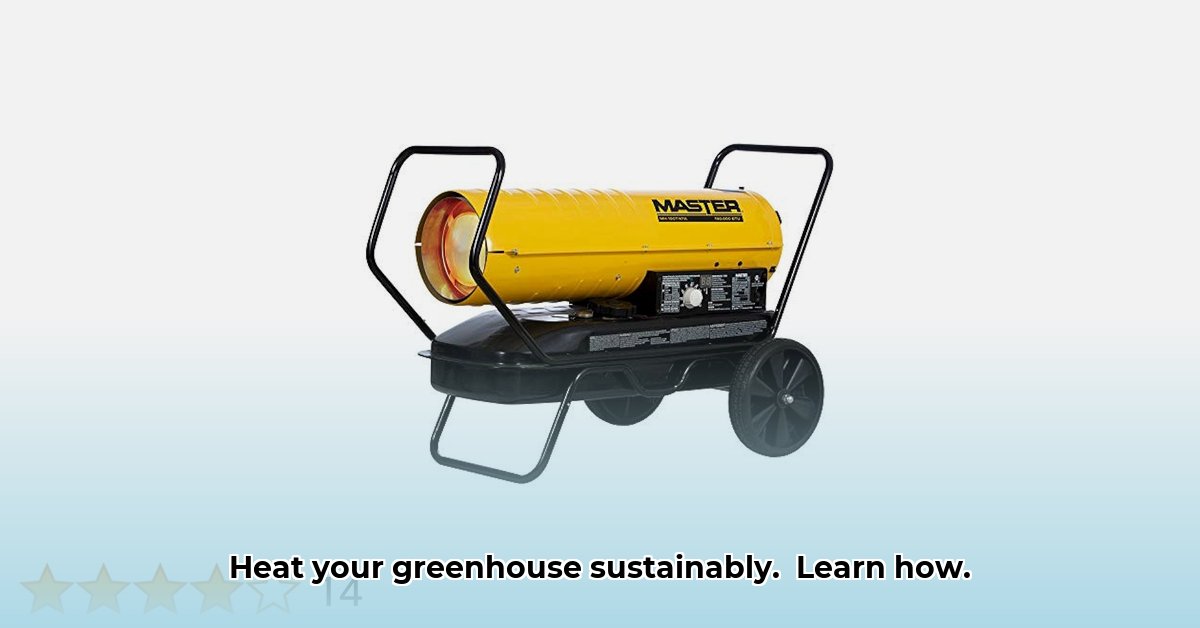
Finding the right heating solution for your greenhouse can be challenging, especially when prioritizing sustainability. This article examines the role of diesel heaters, often available at Tractor Supply, in sustainable agricultural practices, weighing their pros and cons against alternative approaches. We'll explore various heating methods, cost considerations, and actionable steps to optimize your greenhouse heating strategy for both environmental responsibility and economic viability. For additional heating options, check out these heat lamps.
The Challenges of Eco-Friendly Greenhouse Heating
Sustainable agriculture demands minimizing environmental impact. Traditional heating methods, while seemingly inexpensive initially, often fall short. Fossil fuels such as propane and natural gas contribute significantly to greenhouse gas emissions, impacting climate change. While cleaner alternatives like solar and geothermal offer long-term environmental benefits, they generally require substantial upfront investment. This presents a significant trade-off: balancing immediate financial costs with long-term environmental responsibility. The decision mirrors the choice between a fuel-efficient electric vehicle and a gas-guzzling truck; both reach the destination, but with drastically different long-term consequences.
Diesel Heaters: A Balanced Perspective
Diesel heaters, readily available at retailers like Tractor Supply, offer efficient heating for smaller greenhouses or as supplemental systems in larger operations. However, their environmental impact cannot be ignored. Direct diesel combustion releases harmful emissions. Therefore, a thorough evaluation of alternatives and a strategic approach are crucial. The suitability of a diesel heater from Tractor Supply within a sustainable framework depends on various factors, and a simplistic "yes" or "no" answer is insufficient. The question becomes: how can we minimize the negative impacts while maximizing the benefits?
Beyond Diesel: A Multifaceted Approach
Minimizing reliance on diesel heaters is achievable through a diversified approach. A layered strategy combining passive solar heating, robust insulation to retain heat, and intelligent temperature control technology can drastically reduce the need for supplemental heating. This integrated approach can significantly decrease energy consumption and environmental impact.
Key Factors in Choosing a Greenhouse Heating System
Selecting the optimal greenhouse heating solution depends on several key factors. Greenhouse size is paramount; heating a large commercial operation differs greatly from heating a small home greenhouse. The types of plants significantly influence temperature requirements. Local climate conditions also play a crucial role, with colder climates demanding more powerful heating systems than milder ones.
Long-Term Cost Analysis: Beyond the Initial Investment
While the initial purchase price of a diesel heater from Tractor Supply may seem appealing, long-term costs must be carefully considered. Fluctuating diesel fuel prices introduce budgetary uncertainty. Furthermore, the environmental costs associated with diesel combustion need to be factored into the total cost of ownership. Renewable energy systems, while initially more expensive, often translate to lower operational costs over time, while significantly reducing the environmental footprint.
Combining Methods: A Strategic Approach
Optimal greenhouse heating typically involves a combination of technologies. For instance, a small diesel heater could serve as emergency frost protection, while passive solar heating and efficient energy management handle general warming requirements. Such a tailored approach maximizes efficiency and aligns with specific operational needs and environmental goals.
The Future of Sustainable Greenhouse Heating
Ongoing research and development continuously advance greenhouse heating technology. The future likely involves increasingly efficient systems, sophisticated controls, and wider adoption of renewable energy sources. The growing demand for sustainable farming practices will drive innovation in this area. Staying abreast of advancements in energy efficiency in agriculture, renewable energy applications, and cost-effective solutions is vital for making informed decisions. Hybrid systems integrating various renewable and conventional methods may become increasingly prevalent, offering a balanced and practical solution.
How to Choose Cost-Effective Sustainable Heating for Small Greenhouses
Key Takeaways:
- Maintaining optimal greenhouse temperatures is essential for plant health and maximum yield.
- Diverse heating methods exist, each with its unique energy efficiency and environmental impact profile.
- Factors like greenhouse size, climate, budget, and crop types significantly influence heating system selection.
- Both initial investment (CAPEX) and long-term operational costs (OPEX) must be considered.
- A balanced approach integrates economic and environmental considerations.
Assessing Your Needs: A Crucial First Step
Before selecting a heating system, a thorough assessment of your greenhouse is necessary. Size, insulation quality, and climate all significantly influence heating requirements. This preliminary assessment is critical to choosing the appropriate system.
Passive Solar Heating: Harnessing Free, Renewable Energy
Passive solar heating leverages the sun's energy, offering a cost-effective and environmentally friendly approach. This involves strategic greenhouse placement (south-facing in the Northern Hemisphere), using heat-absorbing materials, and controlled ventilation. While effective in sunny climates, it may be insufficient in colder regions or during periods of cloud cover. It serves as an excellent foundation for a layered heating strategy.
Electric Heating: Convenience and Precise Control
Electric heaters offer convenient operation and precise temperature control, though their reliance on potentially non-renewable energy sources impacts both the environment and your budget. Electricity costs fluctuate, affecting the long-term cost predictability.
Alternative Fuels: A Compromise Between Cost and Cleanliness
Propane heaters provide a cleaner burning alternative to some diesel systems, offering good heat output. However, propane remains a fossil fuel. Reliance on propane supply chains introduces potential vulnerability.
Diesel Heaters in Small Greenhouses: Weighing the Trade-offs
For small greenhouses, the high power output of diesel heaters often outweighs their cost and environmental impact. The initial investment and the environmental concerns associated with diesel emissions may negate the benefits in smaller spaces.
The Decision-Making Process: A Multi-Factoral Analysis
Selecting the optimal heating system requires considering several factors:
- Initial Costs: Upfront investment in purchase and installation.
- Operating Costs: Ongoing fuel or electricity expenses.
- Environmental Impact: Greenhouse gas emissions and reliance on renewable resources.
- Maintenance: Frequency and cost of repairs and upkeep.
- Controllability: Precision of temperature regulation.
Improving greenhouse insulation significantly reduces heating needs, lowering both initial and ongoing costs. It's the most cost-effective form of heating improvement.